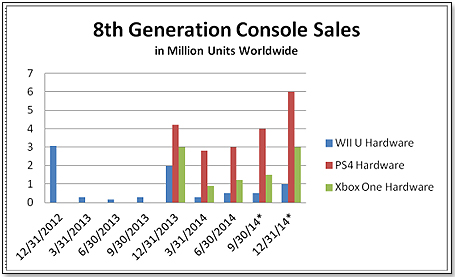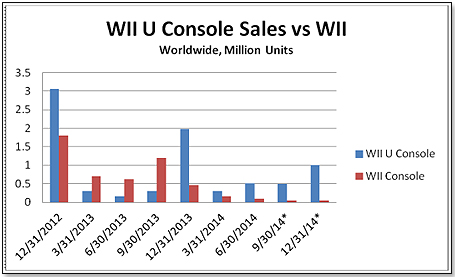
December 28, 2025

September 2014 | Vol. XIII - No. 9
The Wii U is sinking – will it drag Nintendo down with it?
When the Wii was first released on November 19, 2006, people were a little sceptical. The mantra was that the hard core video gamers wanted lots of power for speed and graphics and the hard core gamers were where the action was. The Wii could clearly not compete against the Xbox 360 launched a year earlier or the PS3 that had hit the market the week before. Yes, it was more economical – at $249 the machine was between $50 and $150 cheaper than the Xbox 360 and between $250 and $350 cheaper than the PS3. Yet, this price difference was of no interest to the hardcore player because, clearly, the machine was nor for them. Nintendo did not mind – they had another consumer in their crosshairs.
What Nintendo did was to go after the non-gamer; the young, the old, the females. And the company offered an array of games tailored to the people who were interested in playing occasionally but did not want to make it a fulltime occupation and, equally importantly, did not want to have to take out a second mortgage to do this. The combination of low price and technically unchallenging games did it – the casual gamer was born.
The gamble clearly worked out and the Wii beat both the Xbox 360 and the PS3 by 20% or by 18 million units sold over its life time up to June 30, 2014:
Nintendo was determined to stay with the same model when they kicked off the 8th Generation console cycle with the Wii U on November 8, 2012. After all, what had worked first time would surely work the second time, too. Also, they had the field all to themselves for a whole year until the PS4 and the Xbox One joined the fray in November 2013.
The Wii U was more expensive than the Wii at launch - $299.99 versus Wii’s then price of $199 – but It had all the benefits of the Wii plus some. It was backwards compatible so you could play both Wii U and Wii games on it, you could use Wii accessories, and the machine, just like the Wii, internet capable. In addition, it had much better graphics and much greater memory [32 GB versus 512 MB].
Nintendo firmly expected the Wii U to sell even better than the already fantastically successful Wii and the whole thing should have been a cake walk. All went well at the beginning and the machines flew off the shelves during the first two months after the release, sold to the innovators and the early adopters who go after anything that is new and bright and shiny.
And then, the wheels came off. The majority of the consumers stayed away.
This is how the Wii U performed in comparison to the late-comers PS4 and Xbox One:
The Wii sold about 30 million units during its first twenty months. In comparison, the Wii U did between November 2012 and June 30, 2014, a paltry 6 million.
So, what went wrong?
The first and probably most important thing was that neither the retailers nor the consumers really understood what the Wii U was all about. I talked to a number of my retailer panel friends at that time and they did not see in what way the Wii U was fundamentally superior to the Wii. After all, their current customers were perfectly happy with the Wii graphics, speed and game selection. So, why spend a hundred bucks more for a untested machine if the current one is perfectly good and works like a charm?
This is what happened as a consequence:
In fact, the Wii outsold the Wii U for virtually all of 2013.
The second fact working against the Wii U was that times had changed. In terms of consumer electronics, the difference between 2006 and 2012 is a life time. In 2006 Windows Vista had just been released, the Blackberry Pearl [the first Blackberry with a camera] was the hottest thing on the market and, most importantly, the IPhone and the IPad were merely a glint in Steve Job’s eye, and Samsung was famous for its flat panel TVs.
What happened was that the consumer group Nintendo had created for the Wii had gone for a walk by the time the Wii U rolled around – to the IPhone, to other smart phones, and to the IPad and other tablets. In 2006, nobody was able to play a game on a smart phone or a tablet because these gizmos did not exist then. Now they do. According to research firm Gartner Inc., mobile and tablets accounted for 9% of the time spent gaming in 2011. By mid 2014, this percentage had more than doubled to 19%. Again according to Gartner, more than 256 million tablets will be sold this year.
However, the shift to tablets and smart phones is not the only trend to hit the Wii U. The other is that you do not buy a video game console unless you can play the game you want on it. And this is where Nintendo has a problem. Virtually all major games scheduled for release during the second half of 2014 are shunning the Wii U – Activision with its Call of Duty Advanced Warfare, Destiny and Diablo III; Electronic Arts with Battlefield Hardline, Dragon Age 3, FIFA 15 and Madden NFL 15; TakeTwo with Grand Theft Auto V, NBA 2K 15 and WWE 2K15; and finally Ubisoft with Assassins Creed Unity and Far Cry 4. Needless to say, all of them are available for the PS4 and Xbox One.
Nintendo is now attempting to turn their Wii U wagon around by hitching it to the hybrid steamroller so successfully put on the road by Activision’s Skylanders and followed by Disney’s Infinity. Nintendo’s entry is the "amiibo" and is scheduled for October this year . The range will have its own platform and toys, to be used in conjunction with only the Wii U and the DS. The buyers believe that Nintendo will have a clear disadvantage in terms of console availability in comparison to Infinity and Skylanders which are available on all leading consoles including the Wii and Wii U. In addition, more than half of Skylanders and Infinity toys are used in conjunction with either the Wii or the Wii U consoles and this could further limit the appeal of the Nintendo Figurine Platform range.
The "Amiibo" is likely to have an uphill struggle for another reason. Not only does the range go against well-established competition, it also faces massive promotional campaigns for the new generation Skylanders and Infinity ranges – the Trap Team and Disney’s 2.0 Edition – released at the same time "amiibo" hits the shelves.
It will in fact be interesting to see exactly what strategy Activision is going to follow for the Skylanders now that Nintendo has become a competitor. So far, the Skylanders have if anything helped prop up the Wii U. Today, out of the top 200 games for the Wii U, the Skylanders’ Swap Force is Number 6, the Giants are Number 41, the Trap Team Dark Edition is Number 90, the Trap Team Starter Pack Number 94 and the Giants Battle Pack 1 Number 104. I doubt whether this will continue to be the case for much longer for two reasons. One is that Activision is expected to put much more promotional Dollars behind their PS4 and Xbox One versions at the expense of the Wii U. The second is that the Skylanders Trap Team will be able to be played on tablets which will undoubtedly reduce sales via the Wii U and remove yet another reason for buying the machine.
Early this year, Nintendo boss Saturo Iwata has admitted that "the company is considering a new business structure" which may involve branching out into the mobile arena it has shunned for so long. Nintendo has long dismissed the possibility of launching versions of popular franchises like Mario, Zelda and Donkey Kong on smart phones and tablets, largely through fears of watering down its top earners.
So, the question remains: will the Wii U pull the company down with it or will Nintendo management fundamentally rethink their strategy and begin focusing their efforts where their strength is – games – rather than trying to flog the dying Wii U horse?
Copyright © 2025 TDmonthly®, a division of TOYDIRECTORY.com®,
Inc.





